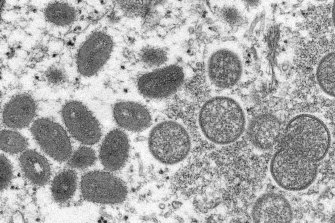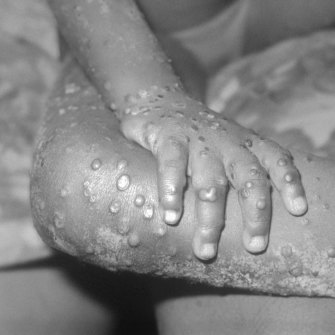Explainer
- Explainer
- Monkeypox
What is monkeypox and should we be worried?
Monkeypox has been recorded in Australia for the first time. What is it?
On May 20, a rare virus made it to Australia for the first time as two returned travellers from Europe, one in Victoria and another in New South Wales, were diagnosed with monkeypox. That number has since grown to at least six – part of more than 1000 cases that have turned up recently across Europe and North America in a surprising outbreak of a disease that rarely appears outside Africa.
The World Health Organisation has warned countries to contain outbreaks fast before they gain a foothold and convened researchers from around the globe because, for the first time, the disease appears to be spreading among people who didn’t travel to Africa – and may be sexually transmitted. But health officials stress that this does not look like the start of another pandemic as monkeypox needs close contact to spread and so can be more easily contained.
WARNING: GRAPHIC IMAGE BELOW

An electron microscope image shows mature, oval-shaped monkeypox virions.Credit:AP
What is monkeypox and how does it spread?
The monkeypox virus is usually seen in wild animals, such as some species of rodents and primates, and occasionally jumps to people. Until now, most human cases have been in central and West Africa, where the disease is endemic but, unlike COVID, it does not spread easily between people except through close contact such as via bodily fluid and infected lesions or touching contaminated clothes, linen or towels.
Australian health officials say transmission via respiratory droplets usually requires prolonged face-to-face contact, though the WHO has noted during this recent outbreak that the risk of aerosol transmission is not fully known and those caring for infected patients would wear masks. Common household disinfectants can kill the virus.
For those who catch it, the disease is typically mild, though there are two main strains: the more severe Congo strain, which has a mortality rate of up to 10 per cent of cases, and the West African strain, where the fatality rate is about 1 per cent.
So far, the WHO says all samples tested have been of the West African strain, with a link to a past strain that spread in a limited fashion in Britain, Israel and Singapore in 2018 out of Nigeria. Further genomic testing is underway around the world to see how the new cases are linked, but they seem to all have one origin. Some patients have been hospitalised, but so far there haven’t been any deaths reported in this current outbreak, according to the WHO. (Although in Africa, there have been more than 1400 suspected cases and 66 deaths this year.)
Monkeypox was first identified by scientists in 1958 after two outbreaks of a “pox-like” disease in research monkeys – thus the name monkeypox. (The first known human infection wasn’t until 1970, in a remote part of Congo.) But scientists now suspect smaller animals such as squirrels are the main reservoir of the virus. Outbreaks in Africa have been ticking up in recent years, particularly in forests where humans and animals are colliding more often due to logging and the wildlife trade.

Monkeypox-like lesions on the arm and leg of a girl in Liberia in 1971. Credit:US Centers for Diseases Control
What are the symptoms and how is it treated?
Monkeypox belongs to the same virus family as smallpox, but it is generally not as severe. It often begins with a flu-like illness: fever, body aches, chills and fatigue. After one to three days, some people may also develop a “chickenpox-like” rash and fluid-filled lesions on the face, arms and legs, which can become infected. Sometimes this rash will be misdiagnosed as chickenpox or an STI.
The incubation period for monkeypox is fairly long, from about five days to three weeks, with children and older people more at risk of severe illness. People will remain infectious until their lesions have healed, Victoria’s Chief Health Officer Brett Sutton says, but generally recover within weeks.
Contacts of those infected are often given a smallpox vaccine, which has been shown to be up to 85 per cent effective against monkeypox and can work up to four days after exposure. (Some antiviral drugs are also available internationally or in development.) The WHO says global vaccine stockpiles are being assessed, and some countries being sent shots.
Since smallpox was eradicated through vaccination, inoculation against it has dropped off, and experts say it may have allowed an uptick in monkeypox cases. But the virus is generally thought to be self-limiting, meaning it burns out quickly when suspected cases are put into isolation.
Anyone who develops monkeypox symptoms should seek care at their nearest hospital, but wear a mask and call ahead first. Returned travellers should take extra care to watch for signs of the virus.
What’s different about these cases?
It’s the first time monkeypox is spreading among people who didn’t travel to Africa, and some cases seem to have been sexually transmitted.
The first European case was confirmed on May 7 in someone who returned to England from Nigeria, which has had an ongoing outbreak since 2017. More than 1000 infections have since been reported across 29 countries from Britain and Spain to Canada, the US and the Netherlands.
Monkeypox is occasionally spotted outside Africa. But it’s typically associated with direct travel to the continent or contact with animals from areas where the disease is common. (A large mystery outbreak in the US in 2003 was traced to a shipment of imported African mammals, including tree squirrels, sold as exotic pets, for example.)
The WHO says the wide geographic spread of this current outbreak, among people who have not travelled to Africa or, in some cases, do not have a clear link between them, suggests that transmission may have been going on for some time, and infections raging undetected. Many have been picked up at a sexual health clinic, where men sought help for lesions on their genitals.
It is unclear if the virus has also become more infectious among people – unlike COVID, which is made of RNA, monkeypox is a DNA virus and so does not mutate as often. The longest transmission chain previously recorded for monkeypox was only seven people long. But, in light of this new outbreak, some scientists are wondering if monkeypox cases have always tended to burn out fast because of the virus itself or because they have hit small villages in Africa with limited numbers of people for the microbe to reach.
So far WHO experts think there has been some kind of shift in how the virus spreads. “What seems to be happening now is that it has got into the population as a sexual form, as a genital form, and is being spread as are sexually transmitted infections, which has amplified its transmission around the world,” David Heymann, an infectious disease specialist at the WHO said last month.
He warned infections could accelerate as people gather for parties and festivals in Europe’s summer months. Some cases already appear linked to a festival in the Canary Islands and another in Belgium.
In May, Heymann said an international committee of experts met via video conference to consider what needed to be studied about the outbreak and communicated to the public, including who is most at risk, whether there is any asymptomatic spread and the various routes of transmission. The committee was not responsible for deciding whether the outbreak should be declared a public health emergency of international concern, WHO’s highest form of alert (and currently applied to the COVID-19 pandemic).
Other experts, including health commissioner of the Lazio region in Italy, Alessio D’Amato, say it is too early to tell if the virus has morphed into a sexually transmitted disease.
Stuart Neil, professor of virology at Kings College London, added this: “The idea that there’s some sort of sexual transmission in this, I think, is a little bit of a stretch.”
Earlier, Francois Balloux of University College London agreed that sex qualifies as the kind of close contact needed to transmit this disease, and the cases so far “do not necessarily imply any recent change in the virus’ route of transmission”.
On May 20, Australia’s acting Chief Medical Officer, Dr Sonya Bennett, said that while many of the monkeypox cases internationally have been among men who have sex with men, this virus has not traditionally been thought of as a sexually transmitted disease and investigations are continuing into the mode of transmission during this outbreak.
– with agencies
This article was originally published on May 20, 2022 and has been updated to reflect new cases and developments.
Let us explain
If you'd like some expert background on an issue or a news event, drop us a line at explainers@smh.com.au or explainers@theage.com.au. Read more explainers here.